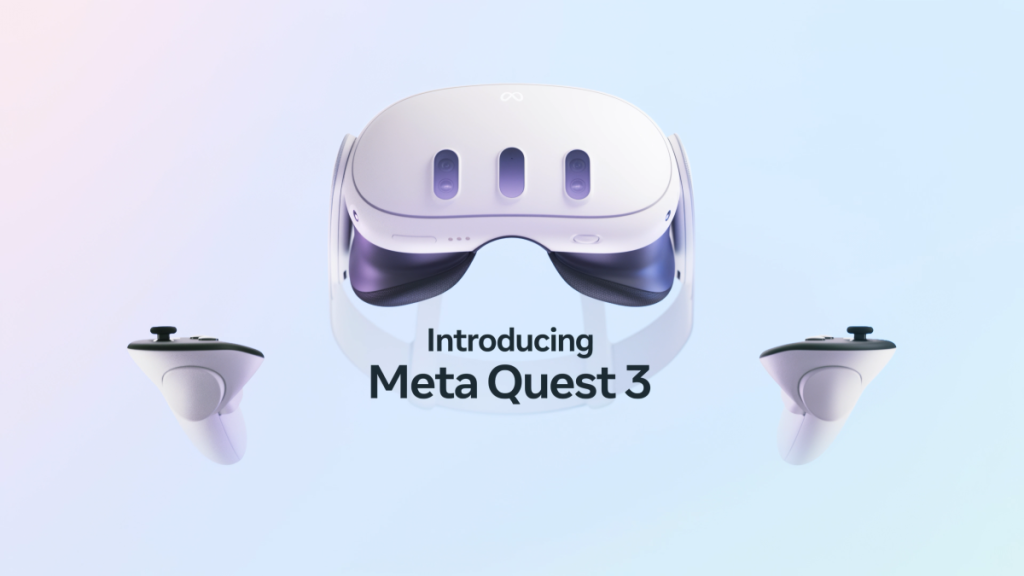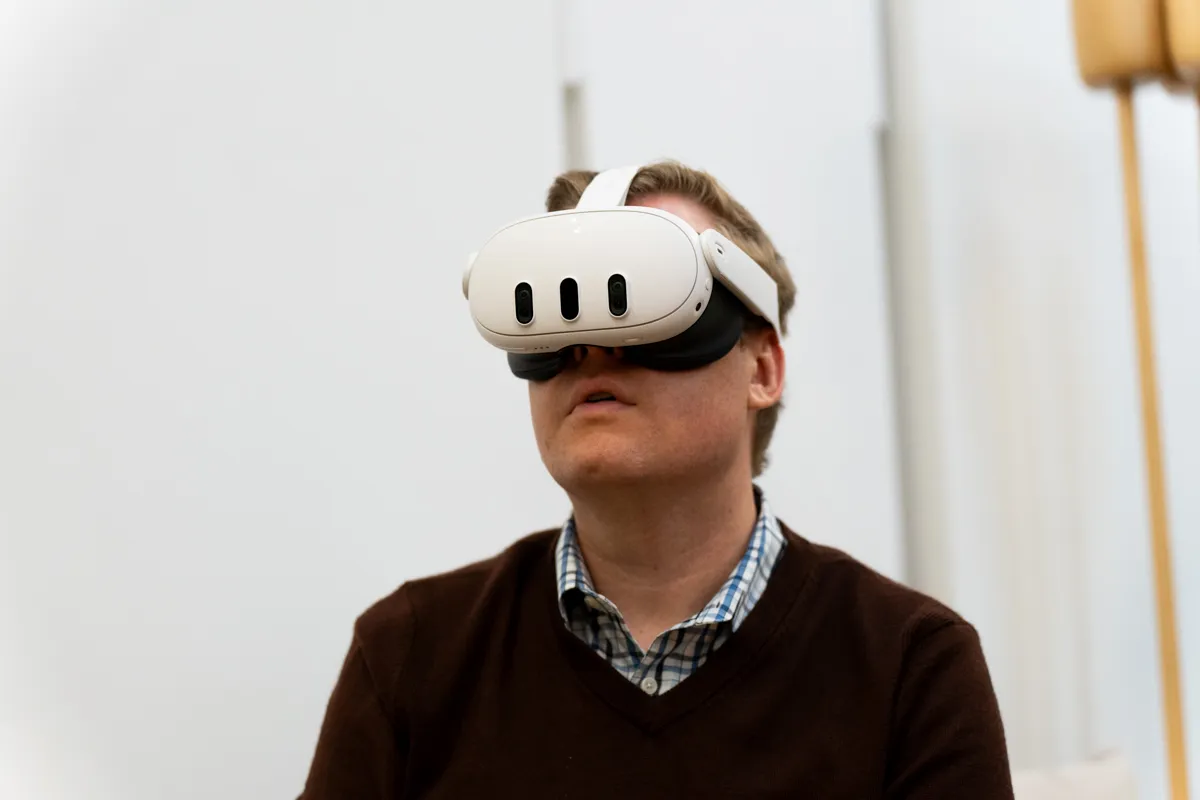As the world of augmented reality (AR) and virtual reality (VR) continues to evolve, Meta Quest 3 has emerged as a significant player, taking substantial steps towards bringing AR and VR closer to mainstream adoption. In this blog post, we’ll delve deep into the latest developments, features, and advancements of Meta Quest 3 and how they’re driving the AR/VR industry forward. In the rapidly evolving landscape of augmented and virtual reality (AR/VR), Meta Quest 3, the latest offering from Meta Platforms, Inc. (formerly known as Facebook), is poised to play a pivotal role in bringing AR/VR closer to mainstream adoption. This report explores the key features and developments surrounding Meta Quest 3, its potential impact on the AR/VR market, and the implications for various industries.

AR/VR technologies have long held the promise of transforming the way we interact with digital content and the real world. The release of Meta Quest 3 signifies a significant leap towards making these transformative technologies more accessible and appealing to a wider audience.
Key Features of Meta Quest 3
a. Enhanced Hardware: Meta Quest 3 boasts advanced hardware components, including improved processors, displays, and optics, offering users a more immersive and comfortable experience.
b. Wireless Freedom: Building on the success of its predecessors, Quest 3 remains wireless, eliminating the need for external sensors or a tethered connection. This enhances user mobility and convenience.
c. Content Library: The Quest platform’s extensive library of games, applications, and experiences continues to grow, with a focus on diverse genres and entertainment options.
d. Hand Tracking and Haptic Feedback: Meta Quest 3 features advanced hand tracking capabilities and haptic feedback, enabling users to interact with virtual environments more naturally and intuitively.
e. Social Integration: Meta has emphasized social integration, enabling users to connect and share experiences with friends in VR, which aligns with Meta’s broader vision of the metaverse.
Market Impact on Meta Quest 3
a. Mainstream Adoption: The improved hardware, user-friendly design, and extensive content library position Meta Quest 3 as a compelling entry point for consumers who may have been hesitant to embrace AR/VR previously. This could catalyze mainstream adoption.
b. Educational and Enterprise Applications: Beyond gaming and entertainment, Quest 3 holds significant potential for education and enterprise applications. Virtual meetings, training simulations, and collaborative projects are areas where this technology could be transformative.
c. Content Development: The growing user base of Meta Quest 3 is likely to attract more developers and creators to produce innovative content and applications for the platform, further enriching the AR/VR ecosystem.
Meta Quest 3 Challenges and Considerations
a. Privacy and Ethics: As AR/VR becomes more integrated into daily life, privacy concerns and ethical considerations regarding data collection and user interactions will need to be addressed.
b. Competition: While Meta Quest 3 is a strong contender, it faces competition from other tech giants and startups in the AR/VR space. Staying ahead in terms of innovation and user experience will be crucial.
c. Accessibility and Cost: Despite efforts to make AR/VR more affordable, cost remains a barrier for some potential users. Wider accessibility will depend on addressing these pricing challenges.
Meta Quest 3 represents a significant step forward in the journey towards mainstream AR/VR adoption. With its improved hardware, user-friendly design, and emphasis on social integration, it has the potential to appeal to a broader audience, from gamers to educators and professionals. However, challenges related to privacy, competition, and cost must be addressed as these technologies continue to evolve.
As Meta Platforms, Inc. continues to invest in AR/VR, and as developers and creators contribute to the platform’s growth, the future of AR/VR is becoming increasingly exciting and promising. Meta Quest 3 is a clear indicator that the boundaries between the physical and digital worlds are blurring, and we are moving closer to the realization of the metaverse. Stakeholders across industries should closely monitor these developments and explore how AR/VR can be leveraged for various applications.
1. The Evolution of Meta Quest: A Brief Overview
To fully appreciate the impact of Meta Quest 3, it’s essential to understand its evolutionary journey. From the original Oculus Quest to the Quest 2, and now the latest Meta Quest 3, this VR headset has continuously pushed the boundaries of technology and user experience. The Quest series has been known for its untethered design, which allows users to enjoy VR experiences without being tied to a computer or gaming console.
Each iteration of the Quest series has seen significant improvements in terms of hardware, software, and content. From the early days of the Oculus Quest, which impressed with its portability and the ability to deliver a compelling VR experience, to the Quest 2, which introduced better visuals and more processing power, the Quest series has been on an upward trajectory.
2. Meta Quest 3 Unveiled: What’s New?
Meta Quest 3 represents the latest milestone in the series’ development. The device brings a host of new features and improvements, such as enhanced graphics, improved tracking accuracy, and more intuitive gesture recognition. These enhancements make for a more immersive and enjoyable VR experience, making it a more attractive option for both casual users and enthusiasts.
Some of the new features include upgraded displays with higher resolution, providing sharper and more vibrant visuals. The tracking system has also been improved, reducing latency and enhancing the overall sense of presence. Additionally, the enhanced gesture recognition allows for more natural and intuitive interactions within VR environments.
3. Pushing the Boundaries: Meta Quest 3’s Enhanced Hardware
Meta Quest 3’s hardware upgrades are a significant driver in bringing AR and VR closer to mainstream adoption. The device boasts a more powerful processor, which enables smoother performance and better handling of complex VR applications. The improved display quality and comfort features, such as a more ergonomic design and lightweight materials, contribute to extended and comfortable VR sessions.
The device’s processing power and graphical capabilities open doors to more sophisticated VR experiences, making it suitable for a broader range of applications beyond gaming. Whether it’s exploring virtual worlds, engaging in professional VR simulations, or collaborating with colleagues in a virtual office, Meta Quest 3 is well-equipped to deliver a compelling experience.
4. Empowering Developers: Meta Quest 3’s Software Ecosystem
In addition to the hardware improvements, Meta Quest 3 places a strong emphasis on its software ecosystem. A thriving developer community is vital for the growth of any technology, and Meta Quest 3 ensures developers have the tools they need to create innovative and engaging VR content. The availability of software development kits (SDKs) and developer tools makes it easier for developers to create unique and immersive experiences for users.
This developer-friendly approach has led to a wealth of creative and diverse VR applications, ranging from educational content to fitness programs and social experiences. These applications not only enrich the VR ecosystem but also make it more appealing to a broader audience.
5. The Content Revolution: Meta Quest 3’s Expanding Library
One of the most significant challenges facing VR adoption is the availability of compelling content. Meta Quest 3 addresses this issue by continually expanding its library of games, apps, and experiences. Users can access a wide range of content, catering to various interests and preferences.
The library includes popular VR games, educational apps, productivity tools, and even social platforms where users can connect and interact with others in virtual spaces. This diverse range of content is a crucial factor in making VR more appealing and accessible to a mainstream audience.
6. Bringing AR and VR Closer to Mainstream
One of the primary goals of Meta Quest 3 is to make AR and VR more accessible and user-friendly. It achieves this through a combination of factors. The user interface is intuitive, reducing the learning curve for newcomers to VR. The device is also designed to be more comfortable for extended use, with adjustable straps and a balanced weight distribution.
Pricing strategies are also designed to attract a broader user base. Meta Quest 3 offers competitive pricing, making it more attainable for those who may have been hesitant to invest in VR previously. The device is marketed as a versatile tool for both entertainment and productivity, further broadening its appeal.
7. Meta Quest 3 vs. the Competition: How Does it Stack Up?
Comparing Meta Quest 3 to other AR and VR offerings in the market provides a comprehensive view of its strengths and weaknesses. It’s essential to assess how it competes with other high-end VR headsets, as well as how it stands out in the context of more affordable options.
When stacked against its competitors, Meta Quest 3 distinguishes itself through its all-in-one design, powerful hardware, and robust content library. It offers a unique balance between performance and affordability, making it a compelling choice for many potential users.
8. The Future of AR/VR with Meta Quest 3
As we look to the future, the impact of Meta Quest 3 on the AR and VR landscape becomes even more significant. The device’s technological advancements, software support, and user-friendly approach pave the way for a future where AR and VR are seamlessly integrated into our daily lives.
With Meta Quest 3, we can expect to see continued growth in VR adoption across various sectors, from gaming and entertainment to education, healthcare, and professional applications. The potential for innovation and creativity in the AR and VR space is vast, and Meta Quest 3 is positioning itself as a driving force in this evolution.
9. Conclusion: Meta Quest 3’s Impact on the AR/VR Landscape
In conclusion, Meta Quest 3 represents a significant step towards making AR and VR more accessible and appealing to a mainstream audience. Its evolution from the original Oculus Quest to the latest iteration showcases a commitment to innovation and improvement. With enhanced hardware, a thriving developer ecosystem, an expanding content library, and user-friendly design, Meta Quest 3 is poised to redefine how we interact with immersive technologies.
The device’s competitive pricing and versatile use cases, along with its ability to stand out in a crowded market, highlight its potential to drive AR and VR into the mainstream. As we look ahead, Meta Quest 3’s impact on the AR/VR landscape promises to be transformative, opening up new possibilities for entertainment, education, collaboration, and much more. Whether you’re a seasoned VR enthusiast or a newcomer to the world of AR and VR, Meta Quest 3 is undoubtedly a device worth exploring.
Watch Video This is Meta Quest 3
1. What is Meta Quest 3?
Meta Quest 3 is the latest virtual reality headset from Meta (formerly Facebook). It’s part of the Oculus Quest series and represents a significant advancement in VR technology, designed to make VR more accessible and appealing to a mainstream audience.
2. How is Meta Quest 3 different from its predecessors?
Meta Quest 3 comes with various improvements, including enhanced graphics, improved tracking accuracy, more powerful hardware, and a growing library of VR content. These enhancements provide a more immersive and enjoyable VR experience.
3. What hardware improvements does Meta Quest 3 offer?
Meta Quest 3 features enhanced hardware, including higher-resolution displays, a more powerful processor, and improved comfort features, such as an ergonomic design. These upgrades contribute to a more comfortable and visually stunning VR experience.
4. How does Meta Quest 3 support developers?
Meta Quest 3 has a developer-friendly approach, offering software development kits (SDKs) and developer tools that make it easier for developers to create innovative and immersive VR content. This encourages a diverse range of applications, enriching the VR ecosystem.
5. What kind of content is available for Meta Quest 3?
Meta Quest 3’s content library continues to expand, offering a wide range of VR experiences. Users can access VR games, educational apps, productivity tools, and social platforms. The diverse content caters to a variety of interests and preferences.
6. How is Meta Quest 3 making AR/VR more user-friendly?
Meta Quest 3 focuses on improving user-friendliness through an intuitive user interface, comfortable design, and adjustable straps for extended use. The device is also competitively priced, making it more accessible to a broader audience.
7. How does Meta Quest 3 compare to other VR headsets in the market?
Meta Quest 3 distinguishes itself through its all-in-one design, powerful hardware, and content library. It offers a unique balance between performance and affordability, making it a compelling choice compared to both high-end and more budget-friendly VR options.
8. What is the future outlook for AR and VR with Meta Quest 3?
Meta Quest 3 is poised to drive further growth in the adoption of VR technology. It has the potential to influence various sectors, including gaming, entertainment, education, healthcare, and professional applications. The future of AR and VR with Meta Quest 3 promises innovation and creativity.
9. Is Meta Quest 3 a standalone device or does it require a computer or console?
Meta Quest 3 is a standalone device, meaning it doesn’t require a connection to a computer or gaming console. It’s designed to be used independently, providing users with the freedom to experience VR without tethering.
10. Can I use Meta Quest 3 for purposes other than gaming?
Absolutely! Meta Quest 3 is versatile and can be used for a wide range of applications. It’s suitable for gaming, education, productivity, social interaction, fitness, and even professional simulations. Its versatility makes it a valuable tool for various purposes.
11. Does Meta Quest 3 offer a comfortable and immersive experience for extended use?
Yes, Meta Quest 3’s design includes comfort features such as adjustable straps and an ergonomic fit to ensure comfort during extended VR sessions. The enhanced hardware and graphics also contribute to a more immersive and enjoyable experience.
12. How affordable is Meta Quest 3 compared to other VR headsets?
Meta Quest 3 offers competitive pricing, making it more accessible to a broader audience. While it provides a high-quality VR experience, its pricing strategy aims to attract users who may have been hesitant to invest in VR technology in the past.
These FAQs should help you better understand Meta Quest 3 and its significance in bringing AR/VR closer to mainstream adoption. If you have any more questions or need additional information, feel free to ask!
Read More : Create Engaging and Conversion-Optimized Content with Cohesive AI Editor
Follow Us on Instagram : https://www.instagram.com/xidexlabs/





